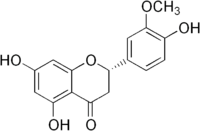Homoeriodictyol
 | |
| Names | |
|---|---|
| IUPAC name
(2S)-5,7-Dihydroxy-2-(4-hydroxy-3-methoxyphenyl)-4-chromanone | |
| Identifiers | |
| 446-71-9 | |
| 3D model (Jmol) | Interactive image |
| ChEMBL | ChEMBL490170 |
| ChemSpider | 66296 |
| ECHA InfoCard | 100.006.523 |
| PubChem | 73635 |
| UNII | EHE7H3705C |
| |
| |
| Properties | |
| C16H14O6 | |
| Molar mass | 302.27876 |
| Except where otherwise noted, data are given for materials in their standard state (at 25 °C [77 °F], 100 kPa). | |
| | |
| Infobox references | |
Homoeriodictyol is a bitter-masking flavanone extracted from Yerba Santa (Eriodictyon californicum) a plant growing in America.[1]
Homoeriodictyol (3`-methoxy-4`,5,7-trihydroxyflavanone) is one of the 4 flavanones identified by Symrise in this plant eliciting taste-modifying property: homoeriodictyol sodium salt, eriodictyol and sterubin. Homoeriodictyol Sodium salt elicited the most potent bitter-masking activity by reducing from 10 to 40% the bitterness of salicin, amarogentin, paracetamol and quinine. However no bitter-masking activity was detected with bitter linoleic acid emulsions. According to Symrise's scientists homoeriodictyol sodium salt seems to be a taste-modifier with large potential in food applications and pharmaceuticals.[2]
Structural relatives investigation based on eriodictyol and homoeriodictyol, found 2,4-Dihydroxybenzoic acid vanillylamide to elicits bitter-masking activity. At 0.1g/L, this vanillin derivative, was able to reduce the bitterness of a 0.5g/L caffeine solution by about 30%.[3]
References
- ↑ Patricia Kaminski and Richard Katz. Yerba Santa Eriodictyon californicum. Flower Essence Society.
- ↑ Ley JP, Krammer G, Reinders G, Gatfield IL, Bertram HJ (July 2005). "Evaluation of bitter masking flavanones from Herba Santa (Eriodictyon californicum (H. and A.) Torr., Hydrophyllaceae)". J. Agric. Food Chem. 53 (15): 6061–6. doi:10.1021/jf0505170. PMID 16028996.
- ↑ Ley JP, Blings M, Paetz S, Krammer GE, Bertram HJ (November 2006). "New bitter-masking compounds: hydroxylated benzoic acid amides of aromatic amines as structural analogues of homoeriodictyol". J. Agric. Food Chem. 54 (22): 8574–9. doi:10.1021/jf0617061. PMID 17061836.